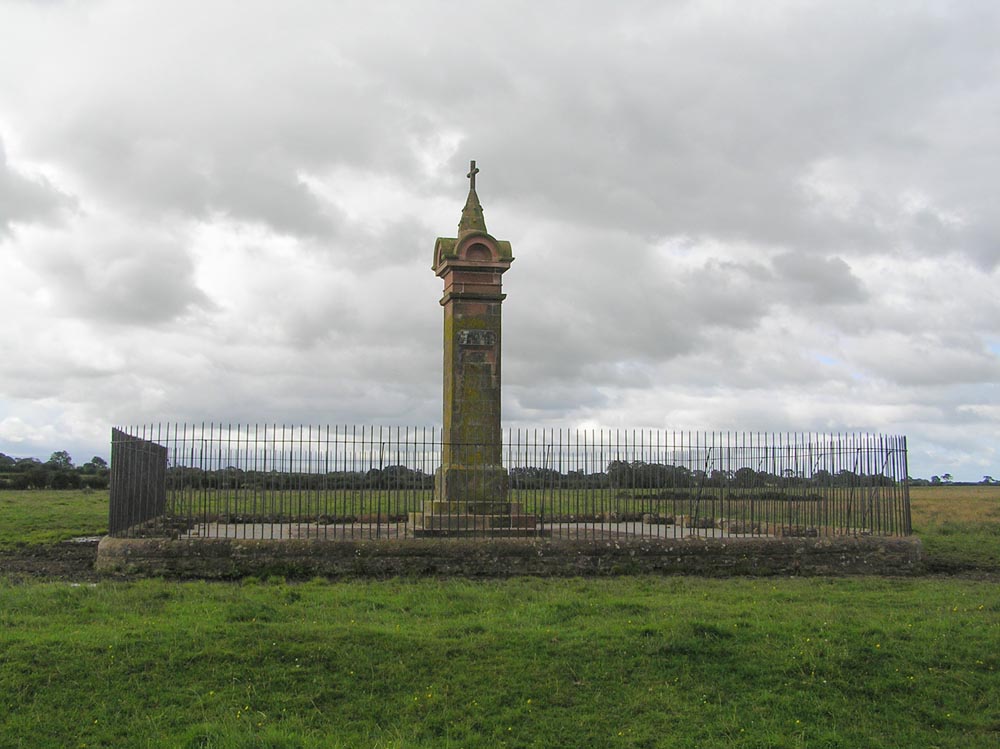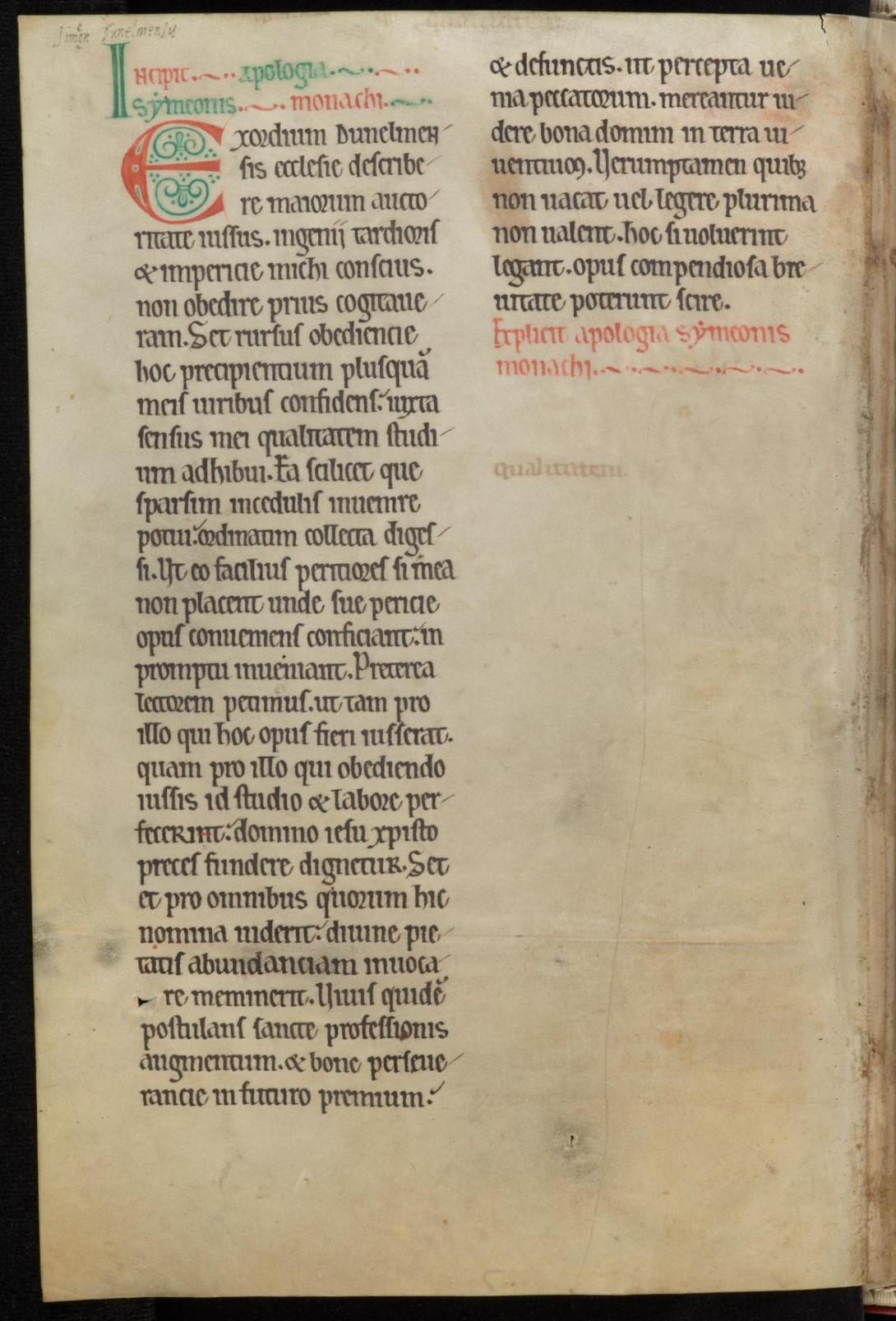|
Battle Of Carham
The Battle of Carham was fought between the English ruler of Bamburgh and the king of Scotland in alliance with the Cumbrians. The encounter took place in the 1010s, most likely 1018 (or perhaps 1016), at Carham on Tweed in what is now Northumberland, England. Uhtred, son of Waltheof of Bamburgh (or his brother Eadwulf Cudel), fought the combined forces of Malcolm II of Scotland and Owen the Bald, king of the Cumbrians (or Strathclyde). The result of the battle was a victory for the Scots and Cumbrians. Written records of the battle There are no strictly contemporary sources for the battle, with it going unnoticed in the '' Anglo-Saxon Chronicle''. Historians know of the event primarily because of historical material assembled at Durham in the twelfth century, though the battle is also noted in one Scottish king-list. In '' Libellus de exordio'', the Benedictine monk Symeon of Durham writing c.1110 recounted a certain ''famosum bellum'', 'infamous battle', of 10 ... [...More Info...] [...Related Items...] OR: [Wikipedia] [Google] [Baidu] |
River Tweed
The River Tweed, or Tweed Water, is a river long that flows east across the Border region in Scotland and northern England. Tweed cloth derives its name from its association with the River Tweed. The Tweed is one of the great salmon rivers of Britain and the only river in England where an Environment Agency rod licence is not required for angling. The river generates a large income for the local borders region, attracting anglers from all around the world. Etymology ''Tweed'' may represent an Old Brittonic name meaning "border". A doubtful proposal is that the name is derived from a non-Celtic form of the Indo-European root ''*teuha-'' meaning "swell, grow powerful". Course The River Tweed flows primarily through the scenic Borders region of Scotland. Eastwards from the settlements on opposing banks of Birgham and Carham it forms the historic boundary between Scotland and England. It rises in the Lowther Hills at Tweed's Well near the rising points of the Clyde -- ... [...More Info...] [...Related Items...] OR: [Wikipedia] [Google] [Baidu] |
Waltheof Of Bamburgh
Waltheof was high-reeve or ealdorman of Bamburgh (fl. 994). He was the son of Ealdred, and the grandson of Oswulf I''De Northumbria post Britannos'' says that Oswulf had a son named Ealdred, father of Waltheof of Bamburgh, father of Uhtred of Northumbria; see McGuigan, ′Ælla and the descendants of Ivar′, pp. 25, 33. and was father of Uhtred the Bold, Ealdorman of Northumbria. The name 'Waltheof' remained in his family when Earl Siward married his great-granddaughter and named his son Waltheof. This son of Siward became Waltheof, Earl of Northumbria, and one of his descendants being Saint Waltheof of Melrose. Additionally, another branch of the family would use the Waltheof name including: Waltheof of Allerdale who was son of Gospatric, Earl of Northumbria. Waltheof of Inverkeithing and Dalmeny was son of Cospatric, and grandson of Waltheof of Allerdale. Another descendant of Gospatric, Earl of Northumbria was Waltheof, Earl of Dunbar. History In 1006 Malcolm II of S ... [...More Info...] [...Related Items...] OR: [Wikipedia] [Google] [Baidu] |
Burgh-by-Sands
Burgh by Sands () is a village and civil parish in the Cumberland unitary authority area of Cumbria, England, situated near the Solway Firth. The parish includes the village of Burgh by Sands along with Longburgh, Dykesfield, Boustead Hill, Moorhouse and Thurstonfield. It is notable as the site of the first recorded North African (Mauri) military unit in Roman Britain, garrisoning the frontier fort of Aballava on Hadrian's Wall in the 3rd century AD. It is also where Edward I of England died in 1307. According to the 2011 census the parish had a population of 1,176. The village is about west of Carlisle city centre. The village has a primary school, a pub and a post office. It also has a statue of Edward I at some distance to the north. Burgh was on the Carlisle Navigation canal from 1823 to 1853, after which it was served by the Port Carlisle railway, which was built on the bed of the canal, until its closure in 1932. From 1856 to 1964, railway trains operating on the C ... [...More Info...] [...Related Items...] OR: [Wikipedia] [Google] [Baidu] |
John Of Fordun
John of Fordun (before 1360 – c. 1384) was a Scottish chronicler. It is generally stated that he was born at Fordoun, Mearns. It is certain that he was a secular priest, and that he composed his history in the latter part of the 14th century. It is probable that he was a chaplain in St Machar's Cathedral of Aberdeen.William Ferguson, ''The identity of the Scottish nation: an historic quest,'' Edinburgh University Press, 1998, The work of Fordun is the earliest attempt to write a continuous history of Scotland. Fordun undertook this task because his patriotic zeal was roused by the removal or destruction of many national records by Edward III of England. He travelled across England and Ireland, collecting material for his history. Collectively, this work, divided into five books, is known as the '' Chronica Gentis Scotorum.'' The first three are unverified historically, which therefore casts doubt on their accuracy. Yet they also form the groundwork on which Boe ... [...More Info...] [...Related Items...] OR: [Wikipedia] [Google] [Baidu] |
William I Of Scotland
William the Lion (), sometimes styled William I (; ) and also known by the nickname ; e.g. Annals of Ulster, s.a. 1214.6; Annals of Loch Cé, s.a. 1213.10. ( 1142 – 4 December 1214), reigned as King of Alba from 1165 to 1214. His almost 49-year-long reign was the longest for a Scottish monarch before the Union of the Crowns in 1603. Early life William was born around 1142, during the reign of his grandfather King David I of Scotland. His parents were Henry of Scotland, a younger son of David I, and Ada de Warenne, a daughter of the powerful Anglo-Norman lord William de Warenne, 2nd Earl of Surrey and Elizabeth of Vermandois, Countess of Leicester, herself a granddaughter of Henry I of France. William was around 10 years old when his father died in 1152, making his elder brother Malcolm the heir apparent to their grandfather. From his father, William inherited the Earldom of Northumbria. David I died the next year, and William became heir presumptive to the new king, ... [...More Info...] [...Related Items...] OR: [Wikipedia] [Google] [Baidu] |
Malcolm II
Máel Coluim mac Cinaeda (; anglicised Malcolm II; c. 954 – 25 November 1034) was List of Scottish monarchs, King of Alba (Scotland) from 1005 until his death in 1034. He was one of the longest-reigning Scottish Kings of that period. He was a son of Cinaed mac Maíl Choluim or King Kenneth II, and The Prophecy of Berchán (which referred to him as ''Forranach'', "the Destroyer") says his mother was "a woman of Kingdom of Leinster, Leinster". His mother may have been a daughter of a Uí Dúnlainge List of Kings of Leinster, King of Leinster. To the Irish annals, which recorded his death, Malcolm was ''ard rí Alban'', High king, High King of Scotland, but his fellow Kings of the geographical area of modern Scotland included the List of Kings of Strathclyde, King of Strathclyde, who ruled much of the south-west, various Norse–Gaels Kings on the western coast and the Hebrides and his nearest and most dangerous rivals, the Earl of Moray, kings or "mormaers" of Moray. Since h ... [...More Info...] [...Related Items...] OR: [Wikipedia] [Google] [Baidu] |
Roger Of Howden
Roger of Howden or Hoveden (died 1202) was a 12th-century English chronicler, diplomat and head of the minster of Howden in the East Riding of Yorkshire. Roger and Howden minster Roger was born to a clerical family linked to the ancient minster of St Peter of Howden, and succeeded his father Robert of Howden as its head, or ''persona''. The date Roger was appointed to the minster by its patrons, the monks of Durham cathedral priory, has been located as around 1169. His title of 'magister' is evidence that he received an education at one of the greater schools of his day, as is also evident from his considerable literary output. Not long after succeeding his father he came into conflict with the lord of Howden and the surrounding district of Howdenshire, Bishop Hugh du Puiset of Durham. Bishop Hugh had made grants of tithes in Howdenshire to the hospital of Kepier in the city of Durham, ignoring the prior rights of the church of Howden. Roger pushed back with the assistance ... [...More Info...] [...Related Items...] OR: [Wikipedia] [Google] [Baidu] |
Historia Regum
The ''Historia Regum'' ("History of the Kings") is a historical compilation attributed to Symeon of Durham, which presents material going from the death of Bede until 1129. It survives only in one manuscript compiled in Yorkshire in the mid-to-late 12th century, though the material is earlier. It is an often-used source for medieval English and Northumbrian history. The first five sections are now attributed to Byrhtferth of Ramsey. Sources It is a "historical compilation" or a "historical collection" rather than a chronicle or anything else. Antonia Gransden and David Rollason list its sources as follows: Much of the compiled material up until 887, i.e. the first five sections, was itself probably derived from an earlier compilation by Byrhtferth of Ramsey, and probably some of it was compiled before the end of the 10th century. The material covering 1119–1129 does appear to be original, and this part may have been authored by Symeon. Manuscripts and authorship The full tex ... [...More Info...] [...Related Items...] OR: [Wikipedia] [Google] [Baidu] |
Symeon Of Durham
__NOTOC__ Symeon (or Simeon) of Durham (fl. c.1090 to c. 1128 ) was an English chronicler and a monk of Durham Priory. Biography Symeon was a Benedictine monk at Durham Cathedral at the end of the eleventh century. He may have been one of 23 monks moved to Durham from the monastery at Jarrow by Bishop William of St Calais in 1083, but the historian Bernard Meehan thinks that it is more likely that Symeon entered Durham in the 1090s. He eventually became precentor of the priory, and examples of his handwriting appear to survive in several Durham books, including the '' Liber Vitae'', the so-called Cantor's Book (whose text he would have had to keep up to date as part of his duties as precentor), and in copies of his own historical works. Works Symeon was author of two historical works which are particularly valuable for northern affairs, the '' Libellus de Exordio atque Procursu istius, hoc est Dunelmensis, Ecclesie'' (''The Little Book on the Origins and Progress of this Chu ... [...More Info...] [...Related Items...] OR: [Wikipedia] [Google] [Baidu] |
Libellus De Exordio
The ''Libellus de exordio atque procursu istius, hoc est Dunhelmensis, ecclesie'' (), in short ''Libellus de exordio'', is a historical work of marked literary character composed and compiled in the early 12th-century and traditionally attributed to Symeon of Durham. It relates the history of bishopric and church of Durham and its predecessors at Lindisfarne and Chester-le-Street (''Cunecacestre''). It is sometimes also known as the ''Historia Dunelmensis ecclesiae'' (English: '' History of the Church of Durham''). Manuscripts The following is a list of manuscripts containing the text. Each manuscript has its own history, and contains different interpolations and notes. In brackets is the letter or letters used by Rollason, its latest editor, to refer to the manuscript in shorthand: * ''Durham, University Library, Cosin V.II.6'', (C) * ''London, British Library, Cotton Faustina A.V'', (F) * '' Cambridge University Library, Ff. i.27'', (Ca) * ''Durham, Durham Cathedral Library, ... [...More Info...] [...Related Items...] OR: [Wikipedia] [Google] [Baidu] |





